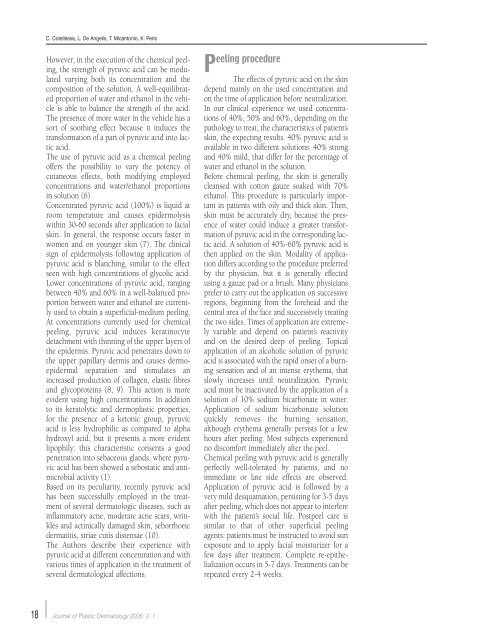Aprile Vol.2 N° 1 - 2006 - Salute per tutti
Aprile Vol.2 N° 1 - 2006 - Salute per tutti
Aprile Vol.2 N° 1 - 2006 - Salute per tutti
You also want an ePaper? Increase the reach of your titles
YUMPU automatically turns print PDFs into web optimized ePapers that Google loves.
18<br />
C. Cotellessa, L. De Angelis, T. Micantonio, K. Peris<br />
However, in the execution of the chemical peeling,<br />
the strength of pyruvic acid can be modulated<br />
varying both its concentration and the<br />
composition of the solution. A well-equilibrated<br />
proportion of water and ethanol in the vehicle<br />
is able to balance the strength of the acid.<br />
The presence of more water in the vehicle has a<br />
sort of soothing effect because it induces the<br />
transformation of a part of pyruvic acid into lactic<br />
acid.<br />
The use of pyruvic acid as a chemical peeling<br />
offers the possibility to vary the potency of<br />
cutaneous effects, both modifying employed<br />
concentrations and water/ethanol proportions<br />
in solution (6).<br />
Concentrated pyruvic acid (100%) is liquid at<br />
room tem<strong>per</strong>ature and causes epidermolysis<br />
within 30-60 seconds after application to facial<br />
skin. In general, the response occurs faster in<br />
women and on younger skin (7). The clinical<br />
sign of epidermolysis following application of<br />
pyruvic acid is blanching, similar to the effect<br />
seen with high concentrations of glycolic acid.<br />
Lower concentrations of pyruvic acid, ranging<br />
between 40% and 60% in a well-balanced proportion<br />
between water and ethanol are currently<br />
used to obtain a su<strong>per</strong>ficial-medium peeling.<br />
At concentrations currently used for chemical<br />
peeling, pyruvic acid induces keratinocyte<br />
detachment with thinning of the up<strong>per</strong> layers of<br />
the epidermis. Pyruvic acid penetrates down to<br />
the up<strong>per</strong> papillary dermis and causes dermoepidermal<br />
separation and stimulates an<br />
increased production of collagen, elastic fibres<br />
and glycoproteins (8, 9). This action is more<br />
evident using high concentrations. In addition<br />
to its keratolytic and dermoplastic pro<strong>per</strong>ties,<br />
for the presence of a ketonic group, pyruvic<br />
acid is less hydrophilic as compared to alpha<br />
hydroxyl acid, but it presents a more evident<br />
lipophily: this characteristic consents a good<br />
penetration into sebaceous glands, where pyruvic<br />
acid has been showed a sebostatic and antimicrobial<br />
activity (1).<br />
Based on its peculiarity, recently pyruvic acid<br />
has been successfully employed in the treatment<br />
of several dermatologic diseases, such as<br />
inflammatory acne, moderate acne scars, wrinkles<br />
and actinically damaged skin, seborrhoeic<br />
dermatitis, striae cutis distensae (10).<br />
The Authors describe their ex<strong>per</strong>ience with<br />
pyruvic acid at different concentration and with<br />
various times of application in the treatment of<br />
several dermatological affections.<br />
Journal of Plastic Dermatology <strong>2006</strong>; 2, 1<br />
eeling procedure<br />
P<br />
The effects of pyruvic acid on the skin<br />
depend mainly on the used concentration and<br />
on the time of application before neutralization.<br />
In our clinical ex<strong>per</strong>ience we used concentrations<br />
of 40%, 50% and 60%, depending on the<br />
pathology to treat, the characteristics of patient’s<br />
skin, the expecting results. 40% pyruvic acid is<br />
available in two different solutions: 40% strong<br />
and 40% mild, that differ for the <strong>per</strong>centage of<br />
water and ethanol in the solution.<br />
Before chemical peeling, the skin is generally<br />
cleansed with cotton gauze soaked with 70%<br />
ethanol. This procedure is particularly important<br />
in patients with oily and thick skin. Then,<br />
skin must be accurately dry, because the presence<br />
of water could induce a greater transformation<br />
of pyruvic acid in the corresponding lactic<br />
acid. A solution of 40%-60% pyruvic acid is<br />
then applied on the skin. Modality of application<br />
differs according to the procedure preferred<br />
by the physician, but it is generally effected<br />
using a gauze pad or a brush. Many physicians<br />
prefer to carry out the application on successive<br />
regions, beginning from the forehead and the<br />
central area of the face and successively treating<br />
the two sides. Times of application are extremely<br />
variable and depend on patient’s reactivity<br />
and on the desired deep of peeling. Topical<br />
application of an alcoholic solution of pyruvic<br />
acid is associated with the rapid onset of a burning<br />
sensation and of an intense erythema, that<br />
slowly increases until neutralization. Pyruvic<br />
acid must be inactivated by the application of a<br />
solution of 10% sodium bicarbonate in water.<br />
Application of sodium bicarbonate solution<br />
quickly removes the burning sensation,<br />
although erythema generally <strong>per</strong>sists for a few<br />
hours after peeling. Most subjects ex<strong>per</strong>ienced<br />
no discomfort immediately after the peel.<br />
Chemical peeling with pyruvic acid is generally<br />
<strong>per</strong>fectly well-tolerated by patients, and no<br />
immediate or late side effects are observed.<br />
Application of pyruvic acid is followed by a<br />
very mild desquamation, <strong>per</strong>sisting for 3-5 days<br />
after peeling, which does not appear to interfere<br />
with the patient’s social life. Postpeel care is<br />
similar to that of other su<strong>per</strong>ficial peeling<br />
agents: patients must be instructed to avoid sun<br />
exposure and to apply facial moisturizer for a<br />
few days after treatment. Complete re-epithelialization<br />
occurs in 5-7 days. Treatments can be<br />
repeated every 2-4 weeks.

















